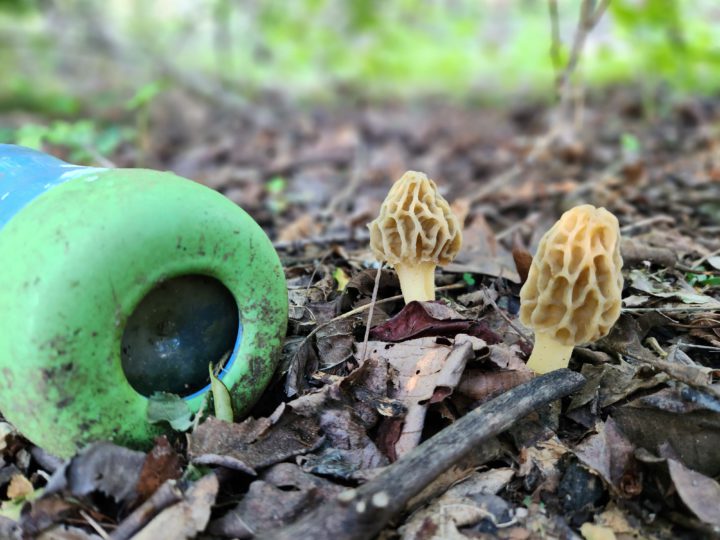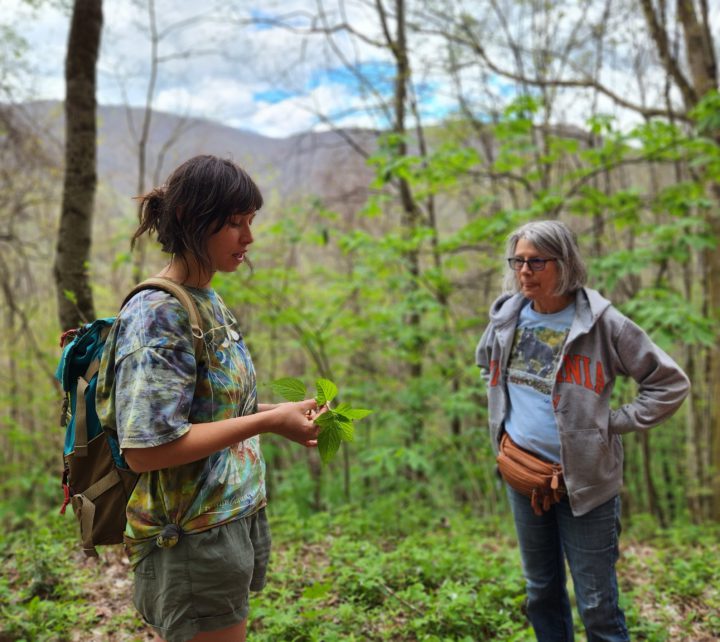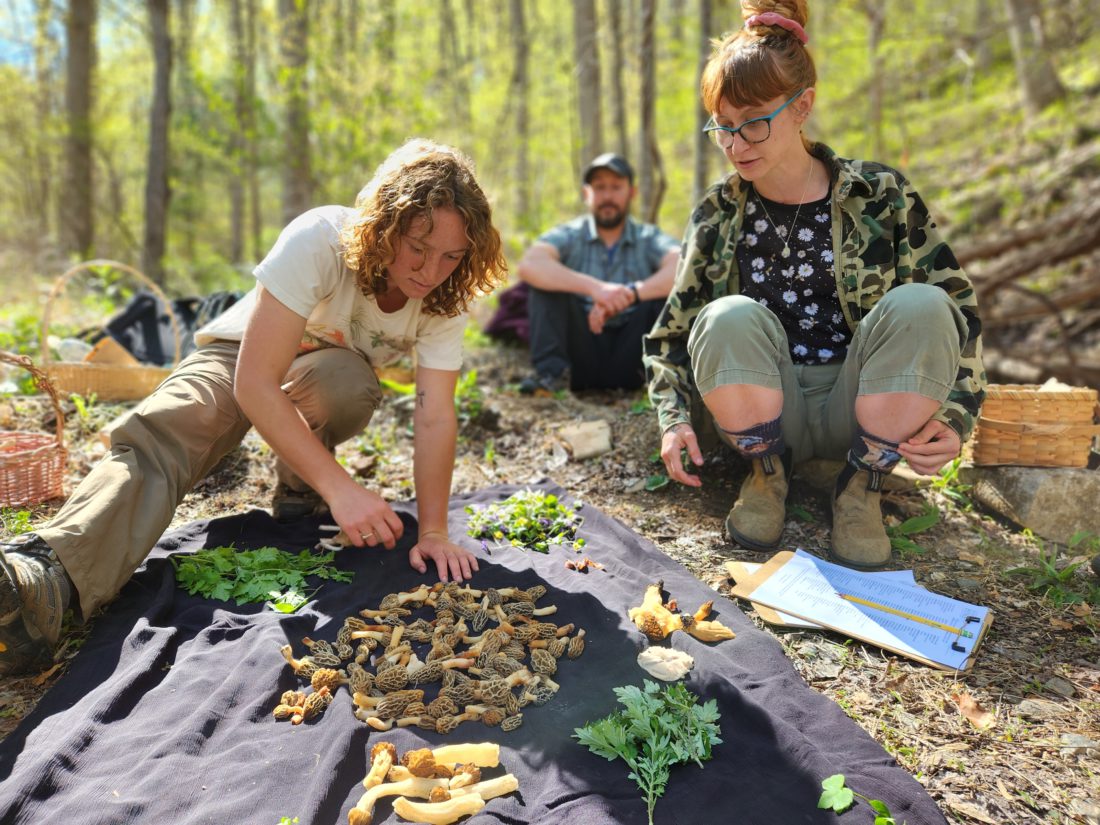Peggy Sauter has a long history of foraging for morels — in her side yard.
About 15 years ago, the avid gardener from Haw Creek bought some mulch that, to her surprise, was full of morel mycelia. She has enjoyed a modest flush every year since.
As easy as it is to stumble upon a morel in the oddest of places — fire pits, foundations, sidewalks, even wallboard — it’s maddeningly difficult to find them in the wild. “If mushrooms are a mystery, morels are an enigma wrapped within that mystery,” Langdon Cook writes in The Mushroom Hunters. Of the many choice edible mushrooms found in Western North Carolina, the morel is arguably the hardest to find. Searching for them can feel like an Easter egg hunt designed by a sadistic adult. Their elusiveness, combined with their deliciousness and the fact that they’re the first choice edible to appear each year, has made them one of the area’s most sought-after mushrooms.
Inspired by her little patch of morels, Sauter bought some guidebooks and started watching wild food enthusiast Adam Haritan’s YouTube videos. She’d caught the mushroom bug, but she didn’t start foraging for them in the wild until last July when she went on a foray with Natalie Dechiara, co-owner of the local foraging company Wild Goods.
Sauter met Dechiara and Wild Goods co-owner Luke Gilbert at their booth at the East Asheville Tailgate Market. “They’re just terrific,” said Sauter. “They’re both so enthusiastic about the subject it’s contagious.”
I discovered the pair the same way last year and left the encounter determined to learn how to forage. In February, I signed up for their April 16 foray, but when morel fever hit Asheville in March, I knew I couldn’t wait that long.
Shut out at Mills River
Foraging for morels has become so popular, the Asheville Mushroom Club, the region’s foremost mycology group, had to devise a special sign-up system to accommodate interest.

I signed up for one on April 1. Only the day before were we told the destination: a spot in Mills River.
After we’d convened in a parking lot next to the river on an overcast Saturday morning, I followed the club’s president, Laurie Jaegers, as she walked downstream, hoping some of her expertise might rub off on me. Morel season only lasts three to four weeks, and its timing varies from year to year. Nature provides some clues. According to Jaegers, conditions are ideal when oak leaves are the size of a squirrel’s ear, trilliums are flowering, and poison ivy is starting to emerge.
To determine where morels are most likely to appear, Jaegers studies maps that identify elevation, slope angles, topography and geology. She also gravitates toward trees that have a mycorrhizal relationship with morels — ash, tulip poplar, elm, apple and hickory trees are best known — but Jaegers shared a pro tip: “Sycamores are underappreciated morel trees.” During the foray at Mills River, the club’s previous president, Frank Bartucca, shared the results of members’ morel foray in the Great Smoky Mountains National Park the day before. They’d only found 18. “This part of the country is not known for morels,” he said. “We really struggle to find them.”
Conditions at the Mills River location were even less conducive to finding morels. Soil temperatures need to be at least 55 degrees five days in a row for morels to fruit, and Bartucca’s soil thermometer delivered readings that consistently hovered around 53 degrees. The fact that spicebush was flowering but the leaves had yet to appear was also bad. Verdict: We were a bit too early.
We didn’t find a single morel that day, but at least we knew why.
The mycelium network
Shut out at Mills River, I reached out to my growing list of foraging friends — let’s call it my mycelium network — and asked who could take me to find morels right now. Dechiara and Gilbert steered me to Kevin Krzyzaniak of Blue Ridge Chaga Connections in Leicester. In late winter and early spring, Krzyzaniak usually focuses on finding medicinal mushrooms such as turkey tail and chaga, but this year he devoted more time to pursuing morels, starting in Upstate South Carolina at the end of February and following the trail as it moved north and into the mountains. He’d be happy to talk to me about morels, he told me, but the person I really needed to talk to was his morel-hunting partner Steve Schachtschneider of Grandfather Mountain Medicinals.
On April 12, Schachtschneider took me, along with his dogs, Kitty and Sandy, to some private property on the south side of the Swannanoa River, where he’d gotten permission to forage long ago. During the drive there, he recalled finding morels with his dad at the base of a walnut tree near their home in Edgerton, Wis. After moving to Asheville, he found himself “staring a morel in the eye” from his fishing boat one day. He quickly found a dozen more and has been trying to replicate the pattern that led to his success ever since: bottomland, gradual slopes, plenty of shade.
Thanks to a mapping class he took three years ago, Schachtschneider approaches morel hunting with the same analytical approach as Jaegers. He relies on soil temperature readings, topographical maps, satellite imagery and the Great Morel’s Facebook group. “When they start posting in South Carolina,” he said, “you know it’s on.”
Schachtschneider has between 30 and 40 spots he regularly visits in search of morels. Unlike most mushrooms, morels don’t pop out of the ground fully formed overnight; instead, they develop over the course of several weeks. By allowing his best spots to rest for a week in between visits, Schachtschneider can get three or four picks from each of them.
By mid-April, he’d found 80 pounds of morels, but it hadn’t been easy. “These are the most challenging mushrooms for me,” he said. He provided an example of their unpredictability: the previous day he and Krzyzaniak had visited a “perfect spot” in Morganton but walked miles in vain. Only after returning to their car did they find 70 morels next to the road where they’d parked.
Given all that I’d heard, I braced myself for a difficult outing at the spot he’d taken me to, but as soon as we got out of the car, Schachtschneider lifted his walking stick and pointed at two morels beneath a butternut tree. He also gave me some advice: Looking out is better than looking down, and looking uphill is better than looking downhill. Together we found 68 morels in less than two hours.
Flush with success, we moved 8 miles downriver to a spot with nearly the same conditions but didn’t find a single morel.
“Every time I think I have these things figured out,” said Schachtschneider, “they throw a curveball at me.”
‘They get in your head’
After my one-on-one excursion with Schachtschneider, the Morel and Ramp tour I took with No Taste Like Home on April 15 initially felt a little crowded. Guide Christian Marr and her assistant June Mader led seven of us up the side of a mountain on 350 acres of private property near Barnardsville. With fields of larkspur giving way to patches of trillium and elevations fluctuating between 3,000 and 3,900 feet, the terrain was stunning.
During the foray, Marr admitted to being obsessed with mycology. “Mushrooms dictate most of my life choices,” she said. “They are my bosses.” Morels in particular fascinated her because of their capricious nature. “They have so many mysteries. Sometimes they’ll come up in the same spot. Sometimes they’ll pop up in a new spot. There’s a lot of variability.”
Mader told us that people often find morels in disturbed areas like the old logging road we were following. Minutes later, Josh Howard, who works for Bounty & Soul in Black Mountain, found two of them in the middle of the path. He’s colorblind, which seemed to help him lock onto their distinctive shape and pattern rather than their tannish color, which is easily concealed by dead leaves. That I’d walked past both annoyed me. Marr articulated my frustration. “There’s an impression that morels like to cause drama because they get in your head.”
As we made our way down a south-facing slope, Mader taught us the squat technique for hunting morels: walk a few steps, then sit on your haunches and look around. It proved to be effective. After we turned around and started making our way back up the slope, we found enough morels to keep our pulses quickened but not so many that we ever felt like it was easy. After six hours in the woods, we dumped more than 130 morels on a black sheet and tried to keep our giddiness in check.
Beginning to intermediate foragers
The foray I went on with Natalie Dechiara, Peggy Sauter and a family from Rockingham County, Va., on April 16 focused on “spring ephemerals,” plants that are only out for a blink of time before the oak canopy forms and summer arrives. While leading us through the woods off North Fork Road near Barnardsville, Dechiara described the “green wall” that most people see when looking at a forest. “As you meet the plants,” she said, “the wall starts breaking down.”

Quicker than I thought possible, I began to recognize many of the plants she’d pointed out, including wood nettle, chickweed, cleavers, may apple, yarrow, sochane, bellwort, greenbrier, waterleaf and toothwort.
Near the waterfall that was our turnaround spot, Dechiara showed us a patch of ramps and educated us about harvesting them sustainably — “Don’t take the roots!” She let us sample some she’d taken from a larger patch.
Several days after the foray with Wild Goods, Sauter and I made plans to look for morels at a spot near Warren Wilson College that June Mader had mentioned to me. Expectations were low. Despite going on three forays with Wild Goods last year and finding 10 pounds of lion’s mane with two friends in November, Sauter describes herself as a “beginning to intermediate mushroom forager,” and I’m closer to “beginning” than “intermediate.” Worse, according to Schachtschneider, local production had “nosedived.” The morels were creeping into higher elevations, and we were looking down low. A diligent handicapper would have made us long shots — at best.
Which made it all the more exciting when we found some.
Storms Reback is an author living in East Asheville. He has written five books, including Ship It Holla Ballas!: How a Bunch of 19-Year-Old College Dropouts Used the Internet to Become Poker’s Loudest, Craziest, and Richest Crew with Jonathan Grotenstein and In Full Color: Finding My Place in a Black and White World with Rachel Dolezal. He has also ghostwritten a handful of books and written numerous feature-length articles for print and online publications.
Editor’s note: This article was updated on May 25.



What a beautiful piece of writing! Thank you!!!